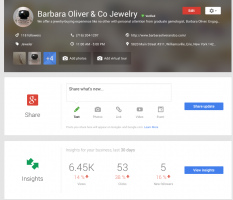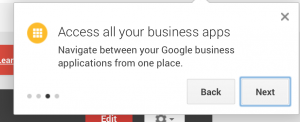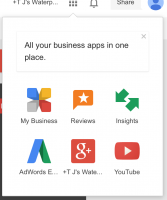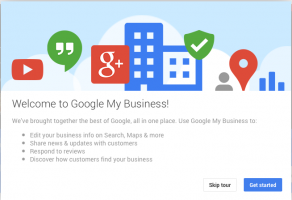Understanding Google My Business & Local Search
Google My Business – A Brand, A Portal, A Platform – Places Makes it to the Promised Land
Today, Google is rolling out Google My Business – a significant small business upgrade to Google Places and Plus. After multiple years of struggle in upgrading Places and merging local into Plus, Google is finally nearing the point where they have a solid platform addressing the needs of small businesses.
My Business is currently rolling out world wide to 236 countries in 65 languages. According to Google, this is their biggest merchant facing launch ever. The product will be simultaneously fully functional on the desktop, Android and iOS once the rollout is completed over the next few days. The Android app should be in the Android store and the iOS app will be available once it is approved by iTunes. From Google’s point of view, the rollout reflects a huge investment in the SMB space and a strong foundation for coming developments.
- A single business facing brand that consolidates social and places messaging.
- An updated interface for editing all Plus Page types.
- Full intergration of Places and Plus.
- A unified Portal with access to other Google business tools for the SMB.
- A platform for future development.
What it isn’t
It isn’t an upgrade that most very large location based companies will be able to take advantage of. The Bulk dashboard is just starting the transition and bulk users have the pain of the change over to the new backend still ahead of them.
This upgrade does not focus on, in fact it may even minimize, the more social, recreational uses of Plus.
Brand – MyBusiness to the rescue
Google’s branding of their SMB facing products has been in crisis since the rollout of Plus. The consumer side Places brand fell by the way side, there was no name given to the local products in the interim and that loss of a branded entity and conflation with Plus left businesses confused. Google had no way to communicate where and what a business should be doing on Google. MyBusiness solves the communication dilemma.
Plus and Places arrive in the Promised land
 The new My Business interface offers up a single, modern, easy to use interface that provides clearer guidance on how to fill out and verify a listing.
The new My Business interface offers up a single, modern, easy to use interface that provides clearer guidance on how to fill out and verify a listing.
The branding mishegas with the transition away from Places was confounded by the complexities of the back end transition from Places to Plus. Google roled out a new, updated Places in April of 2013 dashboard to sit side by side with the Plus dashboard. Businesses that had claimed their listings in the old dashboard were left with a partially functioning product as Google slowly transitioned them to the new dashboard.
To confuse the issue even more a business could verify their business in Plus as well as Places. Even with the rollout in spring 2013 of the obviously interim Places dashboard, businesses were left confused by the choices, options and rules. Once listings had been moved into the new dashboard many businesses found that they had both a Plus Brand page and a Plus local page causing further confusion.
The new unified sign up process and verification process makes it clear (at least to storefront and service area businesses) which page they should choose
A unified Portal – one place where you can get most things done
 The new location dashboard becomes a single place to see not just Plus and Places information but to start interacting with other of Google’s business products like analytics and business view.
The new location dashboard becomes a single place to see not just Plus and Places information but to start interacting with other of Google’s business products like analytics and business view.
 Google claimed goal for the portal is “assist, suggest and inform” to help businesses both complete the verification process AND to easily dig further into other Google products.
Google claimed goal for the portal is “assist, suggest and inform” to help businesses both complete the verification process AND to easily dig further into other Google products.
 According to Google most users of Places and Plus local pages has been the single location business. For that target this interface succeeds very well. There are drop down menus to make most parts of the dashboard immediately available. There are cards to suggest features like analytics and Adwords express if the business doesn’t have them and summary cards of both if they do.
According to Google most users of Places and Plus local pages has been the single location business. For that target this interface succeeds very well. There are drop down menus to make most parts of the dashboard immediately available. There are cards to suggest features like analytics and Adwords express if the business doesn’t have them and summary cards of both if they do.
What it isn’t –
In being very small business focused in seems to reposition Plus as a small business platform, at least for the time being. Both large location businesses and casual users seem to have been ignored.
This focus is primarily on the single location business. In doing so anyone that has to manage multiple pages and or locations is still confronted with the slow and tedious card selection metaphor to pick the correct page and get into the location or page dashboard. This interface, works ok with 2 or 3 pages but once you exceed the visible on screen area it becomes tedious very, very quickly. While a single user can manage 100 businesses via this interface, they may commit suicide in doing so.
Bulk upload is still is a work in progress and this upgrade doesn’t affect the shortcomings in that interface or process.
Brands still have no way to have a single stream across multiple locations nor to easily manage the social presence of multiple pages. Long a promised feature (link) this is a glaring hole in Google’s Plus strategy.
Clearly Google has been working on the (painful?) transition from the old bulk dashboard to the new, more and more of late. Hopefully this portends a future where all of the above failings are addressed.
The recreational and entertainment uses of Plus seem to have been pushed aside in the rebranding if not in a technical sense then at least in a communication sense. Plus users that goto put their local soccer club on Plus may very well be confused by the language as they now fall into the “Brand” page category. Whether this reflects a long term pivot or a short term oversite is unknown.
A platform for future development
For the past 2 years, Google local has been in various stages of being a mess. The complexities of moving millions of businesses to a new platform all the while rebuilding the underlying architecture and inputs have been immense. With this rollout, Google is effectively declaring that the transition is over and they are ready to start delivering SMB solutions on a regular basis.
© Copyright 2025 - MIKE BLUMENTHAL, ALL RIGHT RESERVED.

Comments
21 Comments
I really think Google has been listening and this is such an exciting change that I think solves so many problems and eliminate so much confusion.
Has been so hard to wait for this update over the past couple months. When I finally got my hands on my demo account a few days ago, I was so excited, just could not wait to share the news.
I’m really liking all the new features so far. Seems well integrated and well thought out.
Kudos to the Google team and thanks for all the work that I know went into this update!
Thanks Mike! Heading over to add your post to my announcement now and re-reading your post to see if there is anything new I can add to my Q & A.
Thanks for the Post.
@ Mike
I hope the data syncs over nicely – I’m already noticing for our profile it didn’t pull all of our images over … so it begins … again
Thanks for the review Mike! So far I’m really liking the new Google My Business dashboard (especially the updates to the Insights reporting section). The only downside I can see is I know it’s going to take me weeks to learn to stop calling it “Google+ Local”.
Solid review, Mike. I don’t know how you do it. I’ve been poking around in this new interface for a while and I don’t feel like I’m fully engaged yet.
The first thing I noticed was that the dashboard seems a little more intuitive and less like the labyrinth the common user faced before.
Thanks Mike for the update – you and Linda are always on top of Google Places for Business/Google Places/Google+ Local and now it’s called Google My Business – Oh my – it’s a mouthful! I hope this is the last name change!
I looked at the dashboard for our local page and it’s great – need to go back and digest it a little more and once again update our clients who are already confused from the last upgrade.
Do you think this will help stop duplicate listings? When Google upgraded Google+ Local to the new dashboard last fall, they themselves created duplicate listings (that’s another story).
This is all good – just hope this is it on the local side on Google+. Keeping our fingers crossed.
Susan
One thing I’d really like to have seen – notifications for reviews.
Still, this is a great improvement, so well done Google and thanks Mike for your take on it.
Thanks for clearing things up Mike, I have seen a lot of posts about Google My Business but haven’t been able to fully grasp the whole thing. I think Google have done an amazing job here, finally they have made things simple for us all.
But as you mentioned, this new update does not benefit the people with over 3 or 4 pages assigned to heir account, so I think we can all agree that the next stage for Google is to think about a simple but easy way to manage a larger amount of pages. In my opinion a ‘folder’ organiser would work great for the sort of work I carry out in the dashboard.
Thanks again Mike & a big thanks to Google for finally listening to what we have to say
Mike, thank you for the post. You are always one of the first to post when something new hits. I was just wondering now that there is Google My Business, does this mean that the Google Places and Google+ Local no longer exist? Or will they continue to be places where you can edit you business info?
I just logged in to check the status of a bulk upload and can’t get to the business listings at all! Not sure what the issue is and where the listings went. A Google rep advised last week that he had verified all of the listings, but now there don’t seem to be any.
Jeanne. Can you email me your google account. Google contacted me and wanted to look to make sure it was not a bug.
@Danielle asked:
“I was just wondering now that there is Google My Business, does this mean that the Google Places and Google+ Local no longer exist?”
I’ve been hashing this out with some leading local search consultants today and I asked Google for clarification to be sure we are all clear.
The Places for Business dashboard (where you used to edit listings) was rebranded My Business.
My Business is in fact the dashboard for creating ANY G+ page now, even a non-local brand page.
So yes Places is gone.
But this rebranding was just on the business owner and/or page creation side. So is an internal change on the back end that unifies and simplifies everything.
The branding has not been changed on the public facing page. But really now all pages are just Google+ Pages.
If you want to differentiate you could call the local page a Google+ local page. And many will still call it Google+ Local.
I know, still some confusion out there but hope that helps clarify.
Hi Mike,
Yes indeed that’s huge deal as we speak more about Google traffic than local/places/maps.. But Insights are still not accurate. I can see clicks to website for the client say 2000 last 30 days but in Analytics no referral via Plus… URL
For us as SEO it’s very important to demonstrate ROI and for now except rankings I can’t prove the effectiveness of local exposure either via x-Pack, Blended or Places. We need an explanation from Google what and how is collected to show impressions and clicks on new MyBusiness Dashboard.
Love it! Cant wait to start playing around with it today. Hopefully it’s not buggy.
@todd been playing with it for a week or so and the bugs I saw were minimal and uncommon.
I agree Todd, I’ve been working with it since last Friday too and this seems like the most stable major update I’ve ever seen roll out.
In fact considering what a major upgrade this was and considering it was a huge rollout worldwide – it’s amazing it’s gone so smooth. Kudos to the GMB team!
I’ve only had reports of one semi major problem. Some folks are having an issue where listings that were stuck in the old dash and/or unverified listings have just totally disappeared, so you can’t get access to them.
Have had reports from about 4 people at my forum so far. One of the consultants had previously called support and support told her they were aware of the issue.
But I escalated the issue to Google anyway so they could read all the posts and be sure they knew the various scenarios where this was happening, because each case was a little different.
One interesting observation I wanted to share… has to do partly with how smooth launch went and also has to do with the fact the My Business is a big deal to US, but to the average SMB… maybe not so much.
Now I have to admit, I’ve been so busy with launch, I’ve barely had time to even peek in at the Google and Your Business Forum. However I always at least scan new posts in my feedreader several times a day, to stay on top of issues that come up there.
From the post titles it just totally seems like business as usual.
Still the same old issues are like: where did my review go or why is my page blocked, or my phone number is wrong. And many of them still call it Google Places. So seems like this update just largely went unnoticed.
I even started a discussion thread about the My Business update to get feedback about what folks think, since Jade’s announcement was closed to discussion. Only 2 SMBs even weighed in. And Colan and I bumped it a couple times just to try to get more interaction and some excitement going. NADA.
Just really didn’t seem to make much of an impact on SMBs, oddly enough. But I get that many are busy and don’t even log in that often or read the forum or our blogs, so they may not even be aware yet.
Linda
The absence of discussion is a good thing and reflects the real impact of the product.
Google’s local product should be invisible in the sense of making life easier for SMBs. This product is…. is it Plus? Is it Places. Doesn’t matter wherever you were going before will take you there now. Clarifying the relationship between Places and Plus was never easy, now it is an non issue. Can’t prove the negative but I see that lack of comments as a good thing and reflective of the amazingly and mostly bug free nature of the roll out.
Branding isn’t important to existing users, they already were using the product and don’t care what it is called. It is however critical to bring new users into the fold. Google now has a place where every type of SMB can go in response to Google’s marketing…..
As those new users are brought into the fold the issue of how to interact with Google, what kind of page they should choose etc is much, much clearer. Making many of the problems like “merging brand and local pages” a non issue. So support requests should go down in those areas.
Also if Google brings more external marketing on line then there is a clear message for them to give. In fact their outreach on this product was interesting. They reached out to most Local SEOs. When did they ever do that? Clearly an indicator that they are looking to not only patch up their reputation but to move forward with the product.
New widgets, new features, new uses of Plus via mobile etc… these will all impact SMBs down the road. This is a forward facing product/platform from which they can provide a clear value to the SMB.
So while the day of wasn’t that amazing to the SMB the future can be. The lack of noise in the forums, from my perspective, is exactly what Google needed to put the ugly past firmly behind them.
Totally agree with you on all counts Mike! And as always, you stated it better than I ever could! Off to share your wise insights over at my place now.
Just to be triple sure I understand – at least well enough to tell a SMB client of mine whose brick and mortar business has changed locations and we don’t know what or where to update such that it doesn’t upset any apple carts –
Within the new all-in-one dashboard, she could edit her listing and put the new street address and that change will be automatically updated on maps / search side of things (her priority) AND what used to be her G+ Local Biz page?
Any words of warning from the pros before we do the change? Terrible to feel so afraid to make a simple update to a directory listing. LOL.
Thanks for the great article. Still processing.
@Linda,
Thank you for the clarification in regards to the question, “Does this mean that the Google Places and Google+ Local no longer exist?” You made perfect sense!
@Danielle, glad that one made sense. Sometimes Google scrambles my brain so bad I don’t make sense even to myself.
Comments for this post are closed.